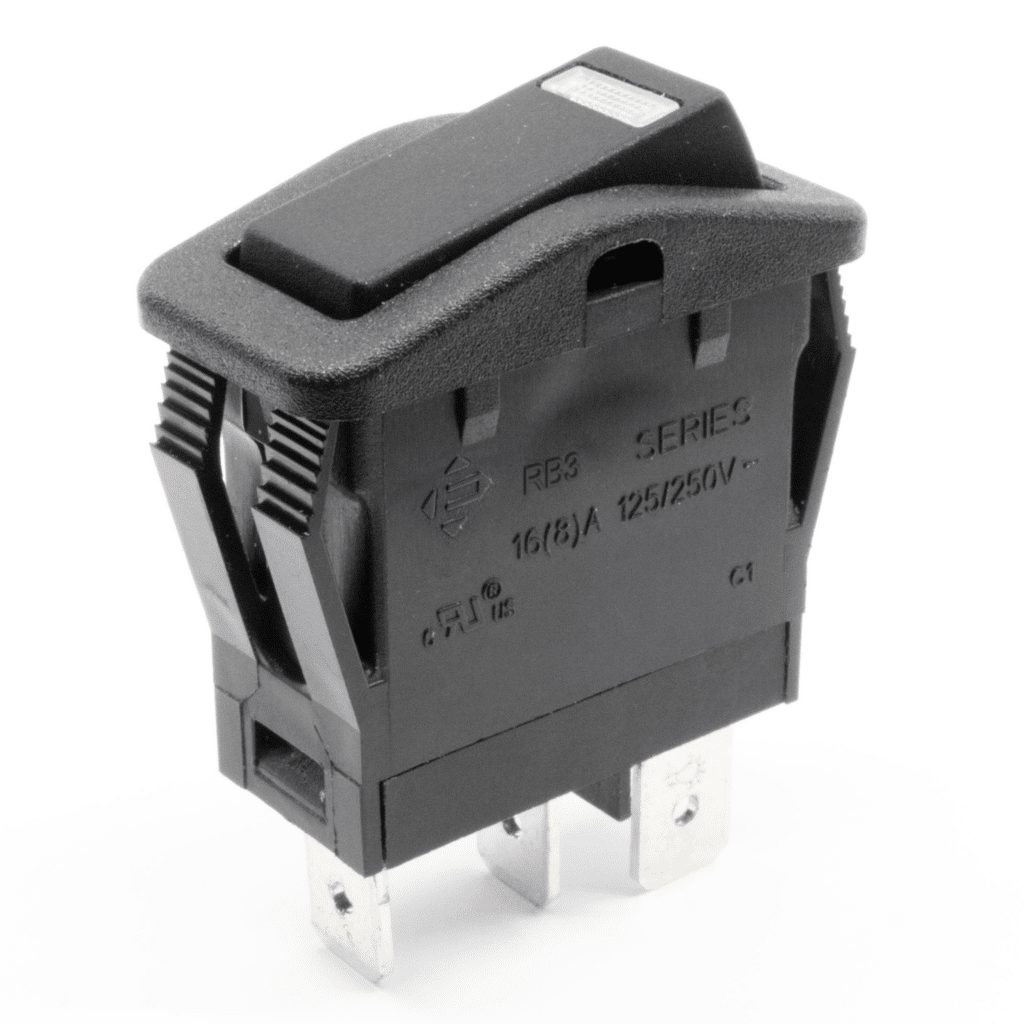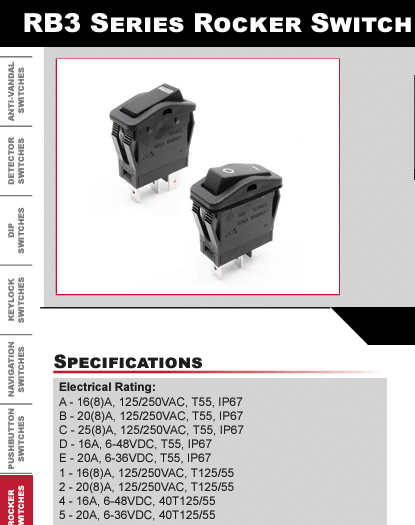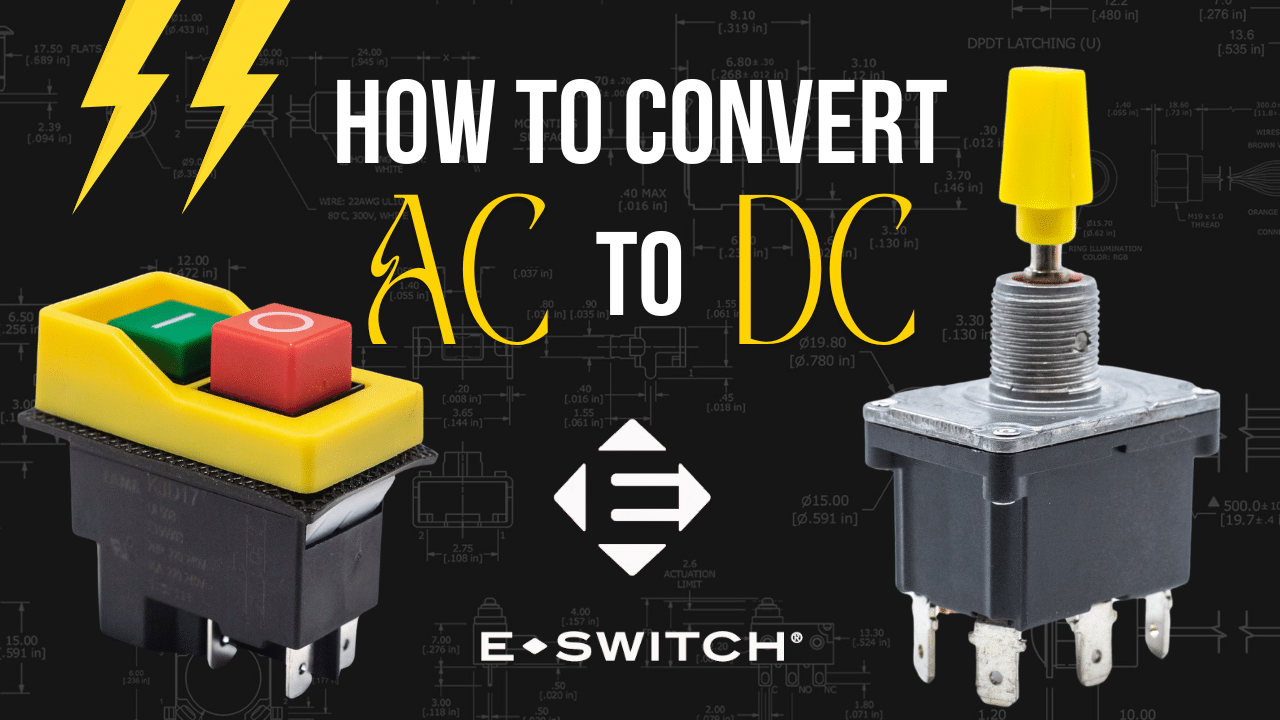When designing an application and considering which electromechanical switch can be used to meet or exceed the maximum load requirements, you might be wondering about the listed voltage and electrical ratings for both alternating and direct current, or maybe you find yourself needing to convert AC to DC voltage.
When it comes to switches — which are used to make and break electrical connections in a circuit — the current-carrying capacity between AC and DC circuits always differs, and you’ll see that represented in the switch’s AC and DC ratings. Here’s an example of E-Switch’s RB3 Series rocker switch with the corresponding section from its data sheet.


Before tackling how to convert AC to DC, let’s cover the basics.
DC vs. AC: Direct Current versus Alternating Current
What is direct current? Direct current means you have a constant current flow. All batteries utilize direct current — when hooked up to a circuit, it’s giving you constant voltage at the source location so the current is then constant.
What is alternating current? This is when the current moves back and forth. All wall sockets utilize alternating current. In the United States, this back and forth action in a wall outlet happens 60 times a second (60 Hertz or 60 Hz).
In summary, AC varies in magnitude and direction while DC maintains a steady flow. It follows that you’ll first need to determine whether your switch is being used in an AC or DC circuit. When AC circuits are broken, the arc is quickly extinguished. However, when a DC circuit is broken, the arc is drawn much longer before it’s extinguished. This can lead to overheating and premature switch failure.
Another key factor is determining if you’re switching a resistive or inductive load. Current rises instantly when a resistive load is turned on and reaches its steady-state value without rising any higher. An inductive load, on the other hand, pulls a large amount of current when turned on before reaching a steady-state value. This causes excessive voltage to appear, meaning you’ll need to ensure that the switch ratings meet or exceed the circuit’s requirements.
Most switches in electronics are fine for AC or DC, as long as you stay at or under the specifications, since they quickly “snap” away, but you’ll run into problems with higher voltage and amperage. For example, switches meant for household wiring won’t be a good fit for high current DC switching applications like a car or solar house battery.
Now let’s look at how to convert AC to DC voltage. Keep in mind that the first two methods below will never provide a precise answer for your conversion, but they will give you a general idea.
#1. How to Convert AC to DC Voltage (Formula)
A switch’s DC Voltage (VDC) rating is always lower than the AC Voltage (VAC) rating at the same current (Amps) rating. For example: A switch rated for 20 amps at 125VAC or (10 amps at 250VAC), would typically have a current rating of less than 1 Amp at 125VDC.
If you’re trying to find out the DC voltage of an AC power supply, then use the formula VAC/√(2) — divide the AC voltage by the square root of 2 to find the DC voltage. Since an AC power supply sends voltage in alternating waves, DC voltage will be lower once you convert it. Write out the formula VAC/√(2) and replace VAC with the AC voltage. Use a calculator to solve your equation if you want the most precise answer. For example, if the AC power source has 120 V, then your formula would be 120/√(2) = 84.85 V in a DC signal. If you have an incandescent bulb on 141 VAC, then the formula shows it’ll glow just as brightly on 100 VDC: 141/√(2) = 100.
The equation also allows us to work backward from knowing the DC requirement to calculating the necessary AC. Keep in mind that the actual DC output will be less than the final calculation. The DC voltage you calculated is simply the “theoretical voltage” — currents have a voltage drop when they’re connected to a device so it won’t have the full amount you’ve calculated for. Only hypothetical conversions maintain 100 percent efficiency.
#2. How to Convert AC to DC Voltage (Factors)
| Voltage Rating | Resistive Load Multiply by: | Inductive Load Multiply by: |
| 125VAC | 1 | 0.66 |
| 250VAC | 0.66 | 0.33 |
| 12VDC | 1.25 | 1 |
| 30VDC | 1 | 0.5 |
| 48VDC | 0.33 | 0.25 |
| 125VDC | 0.05 | 0.03 |
Example: If you have a switch rated for 6A at 125 VAC and want to check for use at 48 VDC: 6A x 0.33 = 2A at 48 VDC.
Again, this is a mathematical rerating and not tested data. The switch should be tested in the application in which it’s intended to be used.
#3. How to Convert AC to DC Voltage (Physically)
By following several steps and using a rectifier, you can convert AC power to DC power. The simplest and most effective means of converting Alternating Current to Direct Current is through a circuit component called a rectifier. Rectifiers are typically constructed from diodes, which allow current to flow only in a single direction.
First you’ll need to select the appropriate rectifier — a half-wave rectifier works for low output application, but a full-wave rectifier is more efficient and suited for high-power applications. You’ll then need to consult the circuit diagram to connect the rectifier input terminals to the AC power source and the output terminals to the load requiring the DC power.
You can then connect the rectifier to the AC power source and the load to the rectifier output before measuring the output voltage using a multimeter. The voltage should match the desired DC output voltage as specified by the rectifier.
